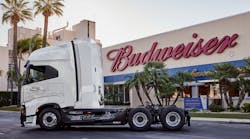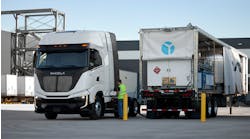It’s not ideal six weeks into the job to be explaining why your only commercially available truck keeps catching on fire, but that was the position Nikola’s president and CEO, Steve Girsky, was in on Sept. 14.
Girsky, a longtime General Motors executive who spent the last three years as Nikola’s chairman of the board, held a virtual investors’ call to provide more details into the production of the hydrogen-powered Tre Fuel Cell Electric Vehicle (FCEV) and plans to create a “hydrogen highway,” and the more pressing matter of why several of the Class 8 Nikola Tre battery’ electric vehicles’ battery packs have experienced thermal incidents, and how the company plans to move forward. Sales and production of the BEV have paused and all 209 units have been recalled.
“It's a setback,” Girsky said of the fires, with the two most recent happening at Nikola facilities last week, “but we're in it for the long haul. We proved the skeptics wrong, who said we couldn't engineer a truck, couldn't build a truck, and couldn't sell a truck. And we're not planning on stopping anytime soon.”
Girsky also said Nikola “recently raised $125 million and have improved our cash position through reduced cash burn, which we believe will give us the capital to get through the fuel cell launch and well into next year.”
He added that the company “has adequate liquidity to fund our near-term business plan and continue towards our path to profitability by the end of 2025.”
Read more: Nikola’s best week ever?
That would be a comeback story for the ages considering the current position. The stock (NASDAQ: NKLA), now at $0.87 (as of morning of Sept. 14) has halved since Girsky took over for Michael Lohscheller, who abruptly left for Europe to address “family health matters.” Shortly after the FCEV went into production, the stock hit $3.40. After the company went public in June 2020, it briefly flirted with $66/share. That was before a disastrous string of events that led to the company’s founder and CEO Trevor Milton being found guilty of wire fraud in federal court.
Girsky noted the company is “certainly not alone when it comes to the challenges faced with the battery technology,” but none have ever been compared to fake blood testing company Theranos. The difference is that Theranos never ended up producing a viable product, while the Tre FCEV is up and running.
According to Girsky, last week the Gamma version of the FCEV hit 900 miles driven in a day. And this week, Biagi Brothers began a customer demo in Ontario, California, using one of Nikola’s mobile hydrogen fueling sites. Nikola expects to have nine mobile fueling sites along Interstates 5 and 10 in California.
Customers approved for California Air Resource Board’s Small e-Fleet program can receive up to a $360,000 voucher to purchase a Tre FCEV, or $240,000 for a Tre BEV (once it becomes available again).
The first FCEV went into production July 31 and came off the line two weeks ago, Girsky said. There are now 210 non-binding orders for the FCEV, with JB Hunt and TTSI being two customers. Alta Equipment will handle sales and service for Nikola in much of the country.
Fortunately for Nikola, the issues with the BEV do not impact the hydrogen-powered Tre Fuel Cell Electric Vehicle (FCEV). The FCEV, which began serial production on July 31, use batteries made by Proterra, while the BEVs rely on Romeo Power batteries.
Nikola acquired Romeo for $144 million in stock last year and liquidated in early June, while still licensing the battery design. Mullen Automotive recently acquired Romeo’s equipment, inventory, and intellectual property for $3.5 million.
More on the thermal incidents
The first thing Nikola did in response to the Tre BEV fires was to recall all 209 Tre BEVs last month and instruct operators to keep the Main Battery Disconnect (MBD) switch on.
“We are taking further precautions by deploying teams to our active fleets to physically monitor the trucks in service,” Girsky said on the call. “We have not encountered any concerns with those trucks that are in operation, and we remain focused on maintaining ongoing communications with our customers and dealers to make sure they all have their questions answered and that they are confident in our trucks and satisfied with their performance.
The trucks will also need to return to the Coolidge, Arizona manufacturing facility for Nikola to make repairs. Girsky said a coolant leak involving the coolant manifold and lines was responsible. The battery packs comprise nine packs and 18 total cooling loops. The lines to the manifolds will need to be swapped out, with the potential in some cases for the entire module needing replacement.
The most recent fires occurred on Labor Day in Tempe, Arizona, and four days later at the Phoenix headquarters.
In a video captured by Fox 10 in Phoenix, a fire truck bombarded the Tre’s battery compartment, located behind the cab with two hoses—one stream arching from the truck parked about over 50 feet away, and another wider stream blasting from an unmanned hose about 20 feet away. Because the lithium-ion cells burn at an extreme temperature, extinguishing the fire may take more than 2,600 gallons of water, according to Nikola’s emergency response guidelines.




